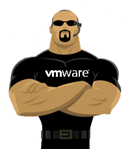ESX and ESXi
 Written by Sam McGeown
on 1/4/2015
Written by Sam McGeown
on 1/4/2015 I tested vSphere 6 quite intensively when it was in beta, but I didn’t ever upgrade my lab - basically because I need a stable environment to work on and I wasn’t sure that I could maintain that with the beta.
I tested vSphere 6 quite intensively when it was in beta, but I didn’t ever upgrade my lab - basically because I need a stable environment to work on and I wasn’t sure that I could maintain that with the beta.
Checking for driver compatibility
In vSphere 5.5, VMware dropped the drivers for quite a few consumer grade NICs - in 6 they’ve gone a step further and actually blocked quite a few of these using a VIB package. For more information, see this excellent article by Andreas Peetz.
 Written by Simon Eady
on 1/4/2014
Written by Simon Eady
on 1/4/2014 One of the things that never fails to amaze me are the superb PDF diagrams I occasionally stumble upon so i thought it would be a useful idea to list some of the the ones I have found on my travels.
One of the things that never fails to amaze me are the superb PDF diagrams I occasionally stumble upon so i thought it would be a useful idea to list some of the the ones I have found on my travels.
vSphere 6 ESXTOP quick Overview for Troubleshooting
VMware vSphere 5 Memory Management and Monitoring diagram
 Written by Simon Eady
on 26/3/2014
Written by Simon Eady
on 26/3/2014 Recently I have had the pleasure to use PernixData but I did come across a bit of a ‘gotcha’ after uninstalling it from my hosts.
Recently I have had the pleasure to use PernixData but I did come across a bit of a ‘gotcha’ after uninstalling it from my hosts.
If like me you use iSCSI then you will likely spend a bit of time setting up your Path Selection Polices to suit your specific needs, so it was interesting to note the following.
When you do uninstall and remove PernixData from your hosts your Path Selection Polices do not revert back to your original configuration rather they revert back to the default vSphere setting of MRU (Most recently used).
 Written by Sam McGeown
on 20/3/2014
Written by Sam McGeown
on 20/3/2014In my previous post
 Written by Sam McGeown
on 13/3/2014
Written by Sam McGeown
on 13/3/2014As a little learning project, I thought I’d take on
 Written by Simon Eady
on 5/3/2014
Written by Simon Eady
on 5/3/2014 There are many ways to tackle the problem of quickly redeploying or recovering ESXi hosts, Host profiles, Auto deploy etc.. however such options are either out of reach for SME/SMB users where their license does not cover such features or they have very small clusters of which Auto deploy etc would perhaps be considered overkill.
There are many ways to tackle the problem of quickly redeploying or recovering ESXi hosts, Host profiles, Auto deploy etc.. however such options are either out of reach for SME/SMB users where their license does not cover such features or they have very small clusters of which Auto deploy etc would perhaps be considered overkill.
So how can we backup the config of our ESXi hosts? There is a great command you can use in
 Written by Sam McGeown
on 27/2/2014
Written by Sam McGeown
on 27/2/2014After having a play with Virtual Flash and Host Caching on one of my lab hosts I wanted to re-use the SSD drive, but couldn’t seem to get vFlash to release the drive. I disabled flash usage on all VMs and disabled the Host Cache, then went to the Virtual Flash Resource Management page to click the “Remove All” button. That failed with errors:
“Host’s virtual flash resource is inaccessible.”
 Written by Simon Eady
on 4/2/2014
Written by Simon Eady
on 4/2/2014Problem
Fairly recently I came across this error message on one of my hosts “esx.problem.visorfs.ramdisk.full”
Fallout
While trying to address the issue I had the following problems when the ramdisk did indeed “fill up”
- PSOD (worst case happened only once in my experience)
- VM’s struggling to vMotion from the affected host when putting into maintenance mode.
Temporary workaround
A reboot of the host would clear the problem (clear out the ramdisk) for a short while but the problem will return if not addressed properly.
 Written by Simon Eady
on 17/1/2014
Written by Simon Eady
on 17/1/2014As a proof of concept I recently tried to virtualize OS X (Mountain Lion) - It is important to note that VMware is now licensed to do so and you can
The following is an overview of the steps I followed to achieve my goal in some cases it was trial an error as I am not a regular Mac user.
 Written by Sam McGeown
on 22/10/2013
Written by Sam McGeown
on 22/10/2013 There are different schools of thought as to whether you should have SSH enabled on your hosts. VMware recommend it is disabled. With SSH disabled there is no possibility of attack, so that’s the “most secure” option. Of course in the real world there’s a balance between “most secure” and “usability” (e.g. the most secure host is powered off and physically isolated from the network, but you can’t run any workloads ). My preferred route is to have it enabled but locked down.
There are different schools of thought as to whether you should have SSH enabled on your hosts. VMware recommend it is disabled. With SSH disabled there is no possibility of attack, so that’s the “most secure” option. Of course in the real world there’s a balance between “most secure” and “usability” (e.g. the most secure host is powered off and physically isolated from the network, but you can’t run any workloads ). My preferred route is to have it enabled but locked down.
